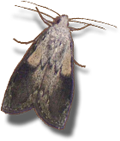Bumblebees |
Abstract | This article introduces the reader to the life of bumblebees (Bombus g.) in both natural conditions and under human supervision. It discusses the options of the latter from various points of view; no matter whether you are a hobbyist or a professional farmer, you will find the information related to your scenario. |
Bumblebees in Natural Environment |
They can be seen usually from April to October occupied with different activities depending on the season. Early on, the large, lone individuals, (queens), hover low near the ground. This is the search for a nest, as explained later. Then they start to regularly visit flowers. Their style of flight is different than in other insects, they fly quite fast (up to 50 km/h, work in winds up to 70 km/h) and high.
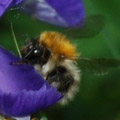 B. hypnorum Bumblebees prefer to visit flowers with much nectar, but they will just as well use any tree in bloom that is available at the time. Their favorite is a cherry tree which can grant advantage to a lot of queens around. The offer of flowers expands during later spring, so it is only noteworthy what they feed on at the end of summer - it is thistle. This is more of a problem than it appears at the first glance - bumblebees require neglected stripes of land and, by pollination, help this pest spread. Fear of plant pest has even earned bumblebee status of intrusive pest himself in Australia. 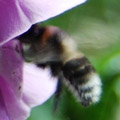 B. soroeënsis A unique activity, known as 'nectar robbing,' includes the biting through the side of a bloom to access nectar effortlessly. Some people believe that this is done by the wasps, but they merely use holes after bumblebees. Anyway, this activity of them is not too beneficial and luckily, they don't do it much. |
The Life Cycle of a Bumblebee |
Let's start the cycle traditionally in the early spring. A hibernated queen wakes up by the warm weather. It is best if she does so on April 1st or as soon as the weather permits. It may happen though that she wakes up earlier. This is likely to become a disaster. There are not enough flowers and she will freeze too. So, after a well-timed awakening, the queen goes find a flower to gain energy. A tree is best as it offers many individual flowers without the need to spend more energy searching. An adult bumblebee eats just nectar. I a few days, she reduces this activity and begins to look for a place to found a colony, or nest. This is remarkable as you can observe many large, beautiful bees slowly moving over the ground. This is the time if you plan to take protographs of bumblebee queens (or plant one in the hive). At this time, you will observe that different kinds of bumblebees look for different places to nest in. They are named by this, after all. The most prolific kind is Bombus terrestris, called the buff-tailed bumblebee, but since said buff tail can be seen just in one rare variety, 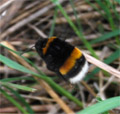 B. terrestris The queen carefully inspects the surfaces of preferred objects. If there is something like a dent, she will even dive in the debris to find out. A single bee visits hundreds, if not thousands, of dangerous places such that it is surprising that she doesn't get seriously wounded. After finding a promising mouse hole or a woodpile, the bee descends into it, makes sure that there is a semi-dry and dark area by feeling it all over and then she returns outside. She will now perform an orienting flight pattern 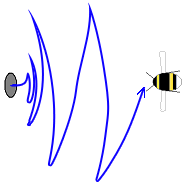 that involves flying left and right in increasing arcs backwards from the entrance. She will finish it off by circling the whole location high in the air. Bumblebees also remember a scent map of the site, so they can return if moved forcibly to another place in their territory. that involves flying left and right in increasing arcs backwards from the entrance. She will finish it off by circling the whole location high in the air. Bumblebees also remember a scent map of the site, so they can return if moved forcibly to another place in their territory.After the nesting site is decided, the queen cannot change her mind even though she theoretically could. She would die if the entrance got caved in (and she was outside). She starts to prepare things for the egg laying. Some combinations of bee kinds and holes require the surface to be waxed, but none of ours were seen doing this. What is necessary is to shape the matter found in the nest to suit the purpose. The queen is capable of cutting grass and rearranging it to form a corridor to the wax cells. She creates these at the bottom of the cavity, so that they won't fall on the side. The cells serve these separate purposes: Nectar and pollen storage (pollen-storer) and brooding. There are minor differences, but they all look like beige olives. Some bees have a different strategy of handling pollen which involves making a hole at the side of a brood cell and attaching pollen to it, so they are called pocket-makers. The queen spends the first day or two by shaping the interior and then she starts to gather pollen and nectar. Depending on the weather outlook, she lays the first eggs shortly after. They need to be heated, so the queen forages for food and buzzes on the cells alternatively. During this period, the queen still leaves the nest only a few times a day. This lasts from 4 to 7 days (depending on weather plus it is hard to tell precisely when the eggs were laid). After the larvae emerge, the working mode takes on a new spin. The queen will now get up early in the morning (6:30), gathering full pollen baskets (lasts over 30 minutes) and returning to feed them for about 15 minutes. This repeats until the evening. The queen fears staying outside overnight, so she stops flying an hour or two before the actual sunset. Good nutrition in this stage is crucial. It takes about 6 days. This behavior changes again when the larvae pupate. (Unlike some other insects, bumblebees do not go through more larval stages, or instars, a larva transforms directly into an adult.) So, when the workers are developing, the queen shows more irregular behavior. The activity ceases at first, but a few days before the workers hatch, the queen does as many flights as she can until the workers finally take over in this. Their development time depends on heat provided and on previous nutrition and is around 10 to 14 days. Hatched workers are unable to fly right away, their wings must dry, but it takes less than 24 hours. Also, unlike in honeybees, they don't go through any ranks in the hive and start foraging early. Workers are usually considered to appear on May 15th, so earlier emergence is a sign of wealthy development. You can also attempt to evaluate the wellness of the colony by measuring the worker (off a photo, do not risk the killing of the first worker!). They range from 8 to 14 mm, which also depends on the kind. The queen promptly lays more eggs to create the next 'generation' of workers. These should develop faster, as everything is already set up and there are up to 7 workers for the job. The next workers should therefore emerge about 20 days later. In central Europe, it takes 3 to 4 generations of workers to bootstrap the colony enough to raise young queens (the objective of the bumblebees' striving), but in hotter climates, queens may be created among much earlier generations of workers. This is well possible as in bumblebees, the decision about the fate of a larva is just in the amount of food and this border is blurry. The first queens can be expected in August. Even if they hatch earlier, they will need to wait for drones from foreign hives to appear. So the queens keep acting as workers in their home hive for a while. At similar time or a little bit later than the queen eggs are laid unfertilised drone eggs. Interestingly enough, these may come from workers as well. Drones are hard to detect, but most of the time, they have yellower thorax hairs than females of the same kind. They are not welcome in the hive, so they go find foreign queens outside. In the meantime, they feed on flowers normally. When both queens and drones are produced, chaos takes on in the hive. The founder queen dies or is even killed by workers who now have much of the instincts of "competing queens". This behavior only occurs in harsher climates though. After all of the workers die out, some of the queens that have mated and found their way back to the hive may attempt to hibernate in it. Most queens, though, find holes in the trees facing north, fallen leaves in drier areas and any such handy places and hibernate there. The place shall not be disturbed overwinter and only heat up on April again to let the queen found another colony in the spring. |
Applications of Bumblebees |
As in any other area of human interests, bumblebees can be kept for profit or enjoyment, bought or raised from scratch.
If you own a greenhouse or you are in charge of a field, you will probably choose the hive purchase method. Here, you are only supposed to place the hive in the middle of the needy plants and open it. The bees will take care about the rest. A nice feature of the biobest hive is that if you need to collect all of the workers promptly, you just switch over to the single-direction entrance and in an hour, the colony is ready for moving.
The hives utilize Bombus terrestris, as it is one of the most prolific and common species. While suitable for such an industrial use, do not expect to keep this one yourself as a pet, as explained later. In these cardboard hives, the bees have rather artificial conditions, especially the large reservoir of sweet liquid meant for tomato greenhouses (no nectar) is a strange difference for them, no doubt. The short entrance doesn't provide any protection against parasites, either. One can thus expect the purchased colony to die right after completing its job, not making it until the raising of the young queens. A colony placed in a constantly closed greenhouse might be lucky enough to survive; in that case, you should let them access the outer world. Moving the hive outside is a problem - they will still remember the original location, also by the scent. If you really want to let your colony succeed, place it at least 5 km from the original location. This will force the bees to remember the new surroundings. On the other hand, you may choose to keep bumblebees as a hobby. This is quite different from conventional pets, it can be compared to a bird box. You only need to invest some time to start it and you only watch them later on. The objective of your bumblebees will be to raise new queens. Common count of these is 10 per colony, so this is a good reference point for the success judgement. You are supposed to protect your bees from parasites too, as explained in the next section. Expect having to exercise much patience in helping your bumblebees. |
Bumblebee-keeping |
While quick projects made upon a sudden affection often work out surprisingly well, you are advised to think ahead about your beekeeping. The implanting season in April is short, so be ready by then. One of the first steps may be, oddly enough, to plant flowers. This is not needed most of the time, but if you plan to use the Polish method (explained later) for rarer species or just live in an area lacking flowers, go ahead and plant dead nettles. During the winter prior to your first season, find a site suitable for a hive. It should be noted that you need to embed the hive in a larger structure that slows down temperature changes, protects from the rain, allows easy implementation of further improvements and allows easy access. A summer-house may be suitable for this. Other readily available shelters include stashes of bricks, wood (only beams or planks) and older cottages that remained on the property after a newer detached house was built. Then search for a suitable entrance place on your chosen structure. It should face north or east, but don't worry, anything goes. As for the height from the ground, prepare to make (or use) a hole about 1 m off the ground for the B. lapidarius or tree-dwelling species, or as low as 10 cm for others (not recommended). The hole you will need drilled in the cottage scenario will be about 32 mm in diameter; if you use a stash of moulded bricks, which is preferred, you will just leave a crevice between a pair of bricks in the right height. Once your protective structure is ready, you will have to build the hive. Although various complex designs exist, there is a way to make a cheap, lightweight, disposable, yet very successful hive of cardboard and some protective hose. This one eliminates the wait for varnish and glue to dry and lose odour, insulates against heat loss quite well and can be replaced for the next year with low additional cost. 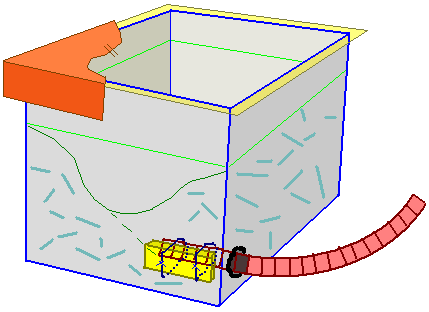
Fit in the bedding. Take a bunch of old, soft, well-dried grass and with scissors, gradually cut about 3 to 5 cm long snippets in the box. If you have other filling too, put it in between the grass and avoid uniform clusters. This is especially true with cotton which shouldn't be used at all, but if you must, cut it to really tiny piecess less than 1 cm in size. Once the box is full enough (to two thirds), shape the grass. Mould a dent in the middle as per the picture. The queen will start the nest in the lowest point of the cavity, so avoid making any dent by the side. Now you only need to make sure there is a good tunnel from the entrance to the center, so push through the grass once more to connect the hose to the surface. It's time to stick the acrylic glass over the box. Use transparent tape. Do not try to close the gap entirely, leave the corners free for ventilation. Do not leave gaps over 0.5 mm wide though. If you have ants in your garden and think that they will attack the bumblebees, you can either prepare a column of bricks having a wide, shallow bowl in between them (for oil as an ant barrier) or stick a band of flypaper around the hive. These papers do dry with time, but one will perfectly suffice for a single season. Put on the lid and prepare to install the hive. Do not turn it over, this might disturb the grass inside. Bring the hive in the shed. Adjust the height of the supporting bricks so that the hose is nearly horizontal. An uphill hose will let odour out, attracting the parasites, a downhill one will cause the bees to pull debris in it, potentially clogging it. One of the last tasks on the site is to fix a landing pad and its shield. It can be made of cardboard as well, but since it's well reusable, you could make the unit of wood. For more protection against the ants, stick some flypaper on the backside and find a way to mount it detached off the wall a bit so that the ants would have to go across paper. Be also careful about mice, they could climb the wall, so consider making this board of a glossy material. Congratulations, your hive is ready! You now need to plant a queen in your hive. This is possible roughly from April 5th, but let's think ahead and prepare some more tools. You will need a large (1 l) jar or two with a screw-on lid,    It's a fine April day and you feel your opportunity. Visit a field boundary, old grass with shrubs near the forest is best. Choose a place near your hive, not only that the bumblebees would suffocate if left in a jar for too long, but they would also lose interest if left in there for long. You could use a bike to reach further areas in time. Wait for the right daytime (2 to 3 pm), put jars in your backpack (a dark luggage is important) and get going. After arrival, grab the jar, unfasten it and listen for a bumblebee. 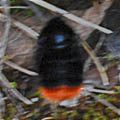 B. lapidarius You suddenly notice the right bumblebee. She performs the cavity search flight pattern. This involves flying low above the ground (10 cm), moving side to side and exploring dents in grass. You approach her against the wind (bumblebees smell human breath and flee) and also without the Sun behind you, the bumblebee would notice the shadow too. You bend with your jar pointing at the bee. Once the bee sits down, you make your move and trap her. After she starts flying against the upper side of the jar, you slide the lid underneath and close it. You can try to find another queen on the spot just in case the first one would not nest, but this is taking the caught one valuable time, so hurry back. Don't forget to put the jar into your luggage so that the queen would settle down and not fly against the glass. After arrival, get the piston and the paper card, go into your room (curtains open, windows well closed) and release the queen. Do this right by the window so that she won't smash on it too hard. Put the retracted piston over her, be careful not to wound her legs. Slide the card between the chamber and the window. Grab the handkerchief, hold the card well on the piston and carry the queen to the hive. Hold the piston tight against the entrance and slide the card aside. Listen to the queen buzzing, the higher the buzz, the worse the pain, so stop moving and wiggle the instrument a bit if she screams too much. Then slowly push the piston in. Watch the queen point her head towards the entrance, then push again. After closing the piston all the way, wait a bit, then carefully pin the hole with the handkerchief. Note the time. Then, somewhere between 15 and 60 minutes later, return and open the entrance. Step back and watch. This will take a while, so you may prepare a chair and an MP3 player for this wait. Closely watch the entrance. Once the bumblebee emerges, stop moving and note the speed and method of her departure. An almost straight flight means failure. You have to go catch another bumblebee, or take another one you brought and left on the window. If, however, the queen performs the orienting flight pattern as shown above, you have almost won. To be absolutely sure, or if you didn't want to wait, place a dry leaf in the entrance to block it the next day and check if it gets pushed away. Another method involves the knocking on the hive. This has two disadvantages: A bumblebee may not buzz even if she is there or she may get frightened and reject the hive. Early after accommodation, the queen may not even leave the hive in the whole day. You have your hive inhabited. One of the first big goals that depend on the bumblebee is the upbringing of the first workers. This means that the queen must not die during foraging and must find enough flowers. Some neighborhoods are just perfect, but if you suspect malnutrition in advance, set a feeding place in the hive during build. Caution must be taken to prevent the bees from drowning in it, so as per biobest, make a cotton bundle, put it in a low bottle and fill it with a mixture of sugar and water, 1:1 per weight. Make sure the wick is damp during the assembly, it wouldn't pull the liquid on its own. The first workers should appear less than a month after inhabiting, the sooner, the better conditions there are. The size of these workers is also an important sign: Tiny workers as short as 8 mm mean that the colony is malnutritioned. Either the queen is ill, or your neighborhood is lacking flowers. Consider building in the feeding bottle the next year. If the workers are up to 14 mm in length, all is right. Watch for parasites though; here is the list of the most common ones:
In April, you can release the queens. It is best if you lay each one on a separate flower on a sunny place. When opening the matchboxes, be careful not to hurt the queen's legs; tear or cut the outer box to release the queen carefully. |
Exotic Methods |
Apart from the means of rearing stated above, there are several other techniques worth mentioning. As for the queen accommodating methods, there is Zapletal's method which requires you to include a feeding bottle. You keep the entrance closed for 3 days. This should increase the likelihood of settlement. Another method which also requires a patch of dumbnettles right next to the hive is the Polish method. In this one, you surround the hive entrance and the nettles with a net (could be the same kind as for the catching of young queens) and have the queen live inside until the workers hatch. This is suitable for really rare finds where you cannot risk the loss of the queen. Besides that, you don't have to let bumblebees fly out at all. It is possible to keep them inside the box the whole season. In this case, you don't even have to supply grass if the hive is heated. An aquarium heater is great because it has a built-in thermostat and it's waterproof. To watch them, use a red light. It goes without saying that you have to supply generous amount of nectar replacement and also pollen; this can be purchased in a beekeeping shop. If you won't let the queen fly out and remember the hive the normal way, she wouldn't found her cells. Initiate her with a few live freshly hatched honeybee nurses. |
Bumblebees and the Law | In many countries, bumblebees are considered to be in danger species. This may impose limitations on what you may do with them. Even though you wish them well and are eager to help, you are committing a crime and a vicious neighbor could rat on you. Not so in Australia though; they try to get rid of bumblebees. |
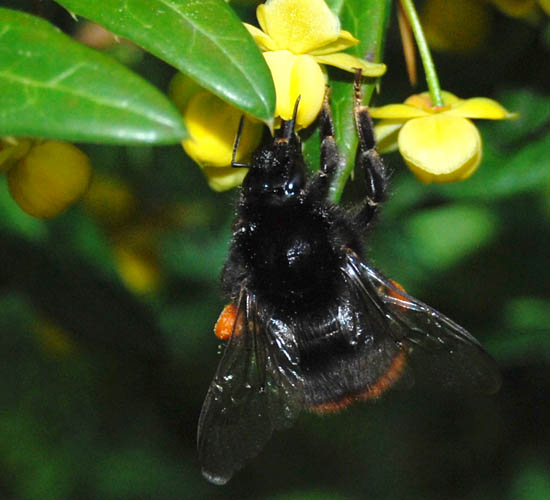
© ZWZ, 2009.  Some rights reserved.
Some rights reserved.
Photographs of hives are sales reference photos of linked companies, bee moth is by Jürgen Peters. Consulted with V. Svoboda.
 Some rights reserved.
Some rights reserved.Photographs of hives are sales reference photos of linked companies, bee moth is by Jürgen Peters. Consulted with V. Svoboda.






